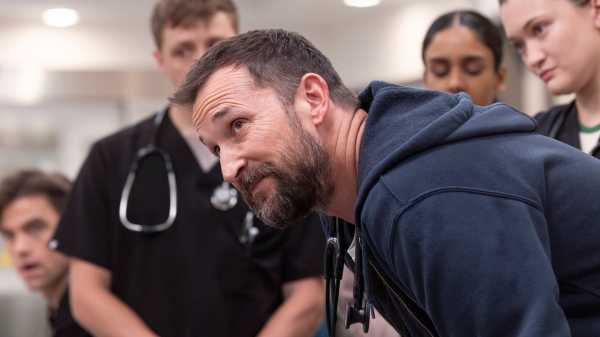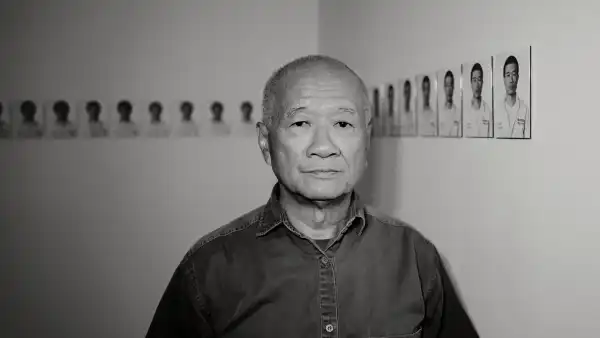
Save this storySave this storySave this storySave this story
On paper, Pittsburgh Trauma Medical Center’s emergency room—the setting of the new Max drama “The Pitt”—is the kind of place you wouldn’t wish on your worst enemy. The waiting room is full by 7 A.M., and it can take as long as twelve hours to be seen by a doctor. Rats scurry across the halls, smuggled in inadvertently between the folds of a homeless man’s clothes. A rough overnight shift brings one physician to the edge of the hospital’s roof, where his friend Michael Robinavitch (“E.R.” veteran Noah Wyle)—known around the ward as Dr. Robby—appeals to his spirit of collegiality: “If you jump on my shift, that’s just rude, man.” The exchange happens minutes into the pilot, and is treated as an everyday occurrence. In “the Pitt,” as Dr. Robby calls the E.R., there aren’t enough nurses, the staff are attacked by their own patients, and the exterminators aren’t coming until next week at the earliest. Feedback suggests that just eight per cent of those who pass through the department are “very satisfied” with the care they receive.
In practice, though, the Pitt is exactly where you’d want to be for some counterintuitive comfort TV. The premise is dead simple: it’s “E.R.” meets “24,” where each episode corresponds to an hour at the hospital, beginning when Dr. Robby clocks in. The fifteen-part season spans one long and difficult day in his life—the fourth anniversary of his mentor’s death in the same E.R. It also happens to be the first day on the job for a gaggle of fresh-faced young medics. Between the large cast of mostly unfamiliar faces and the relentless stream of cases and crises, the show’s pacing is disorienting, almost frantic. Forget a lunch hour; Dr. Robby can’t reliably take a bathroom break without being interrupted by a code red. And yet, the series is also built on nostalgia and predictability. It’s structured such that you know you’ll have your heart broken and mended several times per episode—it’s just a matter of how.
Perhaps I should confess upfront that I’ve never been a fan of medical dramas. Procedurals like “House” seldom speak to me, and I’m immune to the charms of sexy soaps like “Grey’s Anatomy.” The trope of treating patients’ suffering as fodder for personal growth—recently satirized in the promising mockumentary sitcom “St. Denis Medical”—makes my skin crawl. The antiheroic protagonists so common to the genre are similarly off-putting; I’ve already encountered more aloof or condescending physicians than I’d care to in real life. My favorite show in this vein, “This Is Going to Hurt”—a BBC miniseries starring Ben Whishaw as a burned-out ob-gyn—appealed in part because it was as much about the N.H.S.’s budgetary calamities as it was about attending to the sick.
And yet I found “The Pitt” bingeable, even beguiling, for its portrayal of E.R. doctors as not only dedicated medical professionals but also unofficial social workers. Dr. Robby’s patient-satisfaction scores may be abysmal, but you’d never know it, even on his worst day. He allows the parents of a college student who has died of an accidental fentanyl overdose to come to terms with his passing as gently as possible—even to the point of running unnecessary tests—and takes the same soft touch with a pair of adult siblings as they contemplate removing their elderly father from life support. The resident Dr. Robby targets most regularly for discipline is the one whose instincts are most similar to his own: Dr. Mohan (Supriya Ganesh), whom he chides for taking too long with each patient. Her fatal flaw is that she cares too much.
There’s a popular theory that “Law & Order: Special Victims Unit,” which focusses on sexual-assault cases, is beloved by female fans because its detectives pursue assailants with a doggedness that we know to be far less common in reality. “The Pitt” showcases the same kind of old-school heroism. It doesn’t feel divorced from the darkness of our world; one story line hinges on the way anti-abortion laws hamper access to care. But most of the doctors in this universe have learned to respond to that darkness with supreme compassion. Particularly adept is Dr. McKay (Fiona Dourif), who opens up about her history of addiction to a patient living on the streets in an attempt to earn her trust. By spending a few extra minutes with a disoriented makeup influencer, Dr. Mohan is able to save the young woman from a false diagnosis of schizophrenia—what truly ails her, as it turns out, is cosmetics-induced mercury poisoning. The fantasy of hyper-competence here is not just that these doctors almost unerringly reach the right conclusion, but that they treat patients as people in need, rather than as problems to solve.
“The Pitt” is not the first emergency-room drama to burnish its verisimilitude via complex medical jargon, gruesome scenes, and ripped-from-the-headlines grit. Its showrunner, R. Scott Gemmill, was a longtime writer on “E.R.”—and Sherri Crichton, the widow of “E.R.” creator Michael Crichton, has filed a lawsuit against Max’s parent company claiming that “The Pitt” is a reboot of the earlier series in all but name. (The company insists “The Pitt” is “a completely different show.”) Viewers can argue whether the real-time conceit is a gimmick—the sheer amount of plot crammed into a fifteen-hour period certainly strains credulity—but it does differentiate “The Pitt” from its predecessors in substantive ways. The strict time frame means that, unlike in “E.R.,” there’s no prospect of storage-room canoodling, and, in the eleven episodes made available to critics, the camera never leaves the hospital grounds for long. This is a place to check one’s personal life at the door, and the occasional intrusions from outside feel forced. The stark, brightly lit environs are far from a sanctuary, but there’s something consoling about the way the staff continually attempt to fix the ills of a fraying society. “The world’s changed. People are angrier. Tempers are shorter,” one nurse says with a sigh. “And we’re still just trying to help.” ♦
Sourse: newyorker.com







